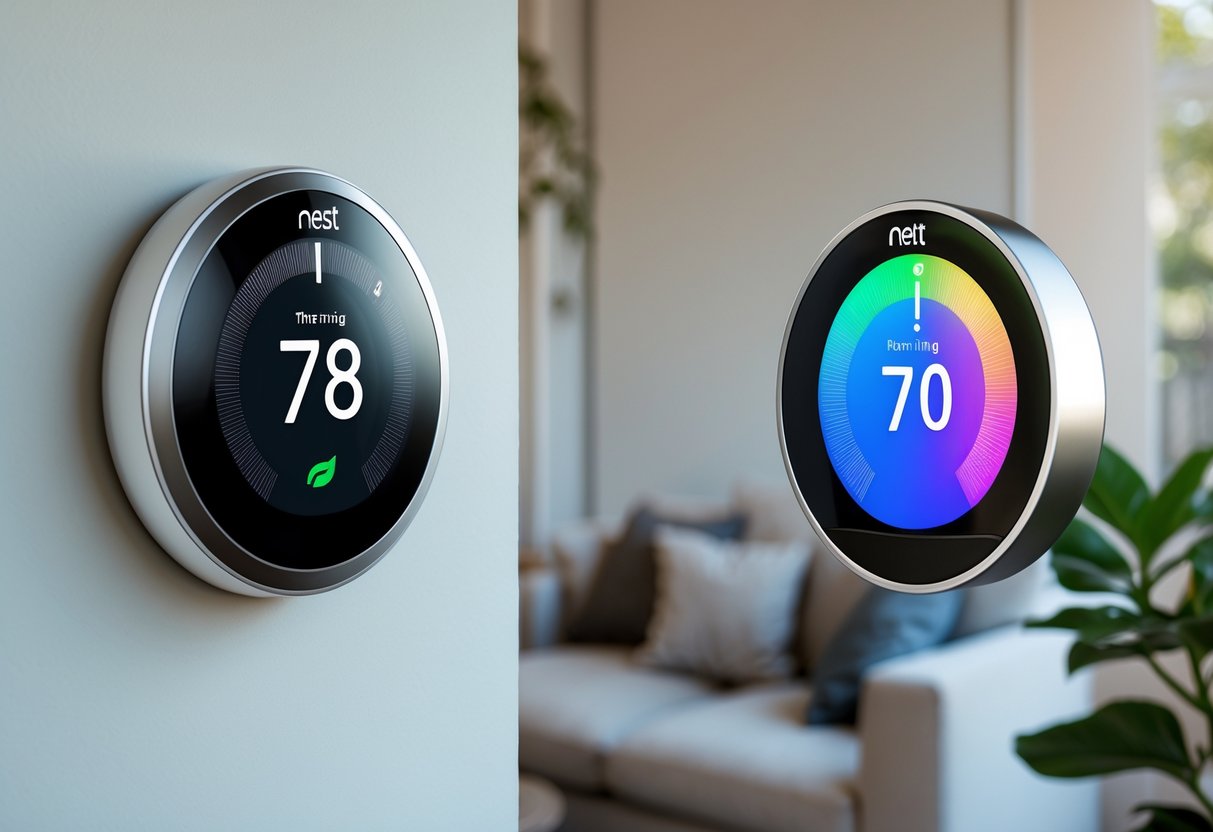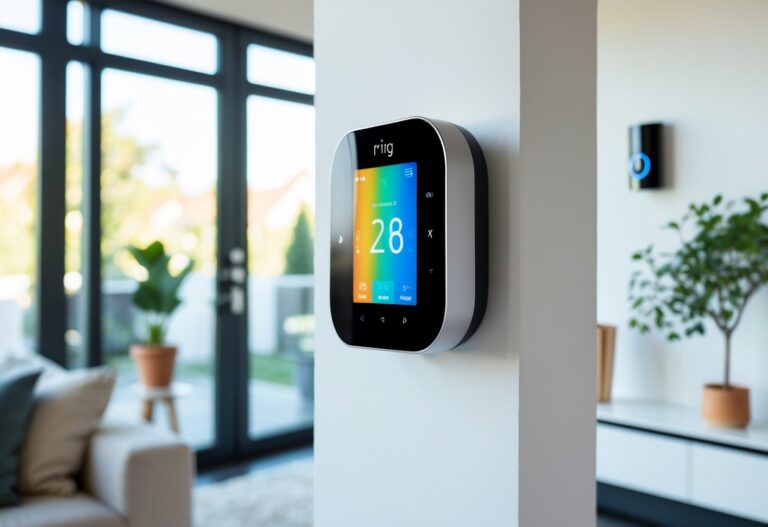If you’re searching for a smart thermostat, you’ve probably seen both the Nest Thermostat and Nest Learning Thermostat. While they may look similar, each one offers different features that can change how you manage the temperature in your home. The main difference is that the Nest Learning Thermostat can automatically learn your schedule and adjust itself, while the basic Nest Thermostat requires you to set your own programs.

Choosing the right model depends on your needs, your tech comfort level, and how much you want to spend. You’ll notice differences in display quality, compatibility, ease of installation, and the kind of controls each device offers. Knowing these details makes it much easier to pick the one that fits your life best.
Key Takeaways
- The main difference is automatic learning versus manual programming.
- Each model comes with different features, controls, and compatibility.
- Cost, value, and ease of use also set them apart.
Core Differences Between Nest Thermostat and Nest Learning Thermostat
Both the Nest Thermostat and Nest Learning Thermostat are designed to save energy and make controlling your home’s climate easier. These models differ in their features, learning abilities, and design choices.
Feature Comparison
The Nest Learning Thermostat includes more advanced features than the standard Nest Thermostat. It has built-in Farsight technology, which lights up the display when you walk into the room and shows useful info like time or temperature. The Learning Thermostat works with more types of heating and cooling systems than the regular Nest Thermostat.
You get energy usage reports, but only the Learning model offers personalized tips for saving energy. The basic Nest Thermostat is compatible with voice assistants and a mobile app for remote control, just like the Learning model. However, it does not auto-adjust based on your habits.
Here’s a quick comparison:
| Feature | Nest Thermostat | Nest Learning Thermostat |
|---|---|---|
| Farsight Display | No | Yes |
| Learning Capabilities | No | Yes |
| Energy Saving Suggestions | No | Yes |
| Compatibility (HVAC) | Less | More |
| Price | Lower ($129) | Higher ($249+) |
Design and Display
The Nest Learning Thermostat stands out with a premium, metal ring and a high-resolution display. The mirrored finish gives it a more modern and expensive look. It’s available in several colors that can match your home decor.
You’ll notice that Farsight works only with the Learning model. This feature lets the screen light up to show information when you’re nearby, making it easy to read even from across the room.
The Nest Thermostat has a more basic design, with a plastic housing and a touch strip on the side instead of the rotating ring found on the Learning version. The display is also smaller and lower in resolution.
Learning Capabilities
The main difference between these models is learning ability. The Nest Learning Thermostat automatically learns your schedule and routines within a few days. It can adjust the temperature based on when you’re home or away without you needing to program it after initial setup.
This thermostat uses built-in sensors and AI to create a schedule that saves energy. Over time, it figures out what temperatures you like at different times of day. The regular Nest Thermostat does not learn from your behavior. You must set schedules manually, and it will not automatically change temperatures unless you adjust them.
Compatibility and Installation
The Nest Thermostat and Nest Learning Thermostat each support a wide range of HVAC systems and smart home integrations. Small differences in compatibility and installation steps may affect which device suits your needs best.
HVAC System Support
The Nest Learning Thermostat is compatible with about 95% of 24V heating and cooling systems in homes. This includes most forced air, heat pump, radiant, and even dual-fuel setups. If you have a more complex system, such as zoned HVAC or multi-stage equipment, the Learning Thermostat is generally a safer choice.
The standard Nest Thermostat supports around 85% of systems. It works well for most basic single-stage and some multi-stage systems but may not work with all types of dual fuel or proprietary equipment. It’s best to use Google’s compatibility checker to see if your system requires a C wire. Some homes need a professional installation to add or manage a common wire for stable operation.
You may also want to add a trim kit or trim plate for a clean look on your wall, especially if the new thermostat is smaller than your old one.
Smart Home Integration
Both Nest thermostats work with Google Assistant and can be controlled by Google Nest smart speakers and displays. This allows you to manage your home’s temperature with simple voice commands or via the Google Home app.
The Nest Learning Thermostat offers slightly better integration for larger or older smart home ecosystems, including broader support for some third-party platforms and older works-with-Nest integrations. The basic Nest Thermostat is optimized mainly for Google Home and does not support every third-party system.
If you want to control your thermostat alongside other smart devices, consider how well each model fits your current smart home setup.
Installation Options
You can install both thermostats yourself with common household tools. The on-screen instructions are clear, and the mounting hardware comes included.
If your HVAC system needs a C wire, you might need professional installation to ensure consistent power. The Nest Learning Thermostat is slightly larger and often covers the area left by old thermostats, so a trim plate might not always be needed. The regular Nest Thermostat is thinner and may need a trim kit for best results.
Many users choose to have a professional handle the installation, especially if wiring is not straightforward or you are upgrading from an older or proprietary thermostat. A technician can also confirm HVAC compatibility and resolve any issues during setup.
Controls and Smart Features
Both the Nest Thermostat and Nest Learning Thermostat offer smart controls designed to simplify managing the temperature in your home. They differ in how advanced their features are, how well they learn your habits, and what apps and platforms they work with.
Mobile App and Voice Assistant Support
You can control both thermostats from your phone using the Google Home app or Nest app, though the Nest Learning Thermostat also supports the original Nest app, which some users prefer for its layout and features. Both models support app-based controls that let you change the temperature, set schedules, and monitor your system from anywhere.
With the Google Home app compatibility, you can connect both thermostats to Google Assistant for voice commands like “Hey Google, set the temperature to 72 degrees.” Both thermostats also work with Amazon Alexa. However, only the Nest Learning Thermostat supports Apple’s Siri through HomeKit, though extra setup may be required.
Supported Commands:
- Change temperature
- Switch between modes
- Check current settings
All these options make it easy for you to control your thermostat hands-free with voice assistants or directly through a mobile device.
Temperature Sensors and Scheduling
A key difference is how both models handle temperature sensors and scheduling. The Nest Learning Thermostat is compatible with Nest Temperature Sensors. These devices can be placed in different rooms so the thermostat adjusts based on where you spend the most time, not just the hallway where it is installed. This gives you better control over comfort throughout your home.
The standard Nest Thermostat does not work with these external temperature sensors; it only measures temperature at its own location.
In terms of scheduling, the Nest Learning Thermostat uses an automatic scheduling system. It can learn your habits in about a week and start setting adjustments by itself to match your daily routine. The basic Nest Thermostat lets you set a simple schedule but does not learn and adapt the way the Learning Thermostat does.
Energy-Saving Technologies
Both thermostats help you reduce your energy consumption, but the ways they do it can be a bit different. The Nest Learning Thermostat uses its proximity sensor to detect when you’re home or away. It can then automatically turn down heating or cooling to save money on your energy bills.
You also get detailed energy reports with the Learning Thermostat, showing how much energy you use and tips for saving more. The auto-schedule feature finds patterns and makes small changes that can help reduce your energy bill without you thinking about it.
The regular Nest Thermostat includes features like Eco mode and basic scheduling, but it requires you to set “away” mode manually or depend on your phone’s location. Both devices are designed with energy savings in mind and may be compatible with the new Matter standard for smart home devices, but the Learning Thermostat generally provides more tools and insights for maximizing your energy efficiency.
Pricing, Models, and Value Considerations
Nest offers a variety of thermostats with differences in price, features, and long-term value for your home. Knowing how each option compares can help you pick the best smart thermostat for your needs and budget.
Price Differences and Budget
The Nest Thermostat is the most budget-friendly option. Its price is usually lower than the Nest Learning Thermostat, making it attractive if you want smart features without spending a lot. Typical prices are around $129–$149 for the basic Nest Thermostat.
The Nest Learning Thermostat costs more, usually priced at about $249–$279, depending on the generation and retailer. The higher cost comes with added features, such as learning your schedule over time and additional sensors.
The Nest Thermostat E is another alternative, often found at a price between the two. It has a simpler design and fewer color options but still offers many smart functions.
When you decide, factor in not just the price, but also whether you need learning features or can do without them.
Available Models and Generations
You can choose from different models, each with its own design and features. The most common are the Nest Thermostat, Nest Learning Thermostat (3rd and 4th Gen), and the older Nest Thermostat E.
- Nest Thermostat (latest version) has a mirrored display and comes in four color options.
- Nest Learning Thermostat (3rd Gen and 4th Gen) offers more premium finishes and a metal ring.
- Nest Thermostat E (mainly white) is discontinued in some regions but may still be available.
Here is a simple comparison:
| Model | Price Range | Color Options | Display Type |
|---|---|---|---|
| Nest Thermostat | $129–$149 | 4 | Mirrored |
| Nest Learning (3rd/4th Gen) | $249–$279 | Multiple (metal) | High-res, color |
| Nest Thermostat E | $169–$189 | 1 (White) | Frosted |
Choose the one that fits your setup and style preferences.
Long-Term Value and Energy Efficiency
The Nest Learning Thermostat stands out for its ability to learn your habits and adjust settings for better energy savings. Over time, this can lead to lower heating and cooling bills.
Both the Nest Thermostat and Learning Thermostat can help improve energy efficiency if set up correctly. The Learning model offers more automation, potentially saving you more money in the long run.
The Learning Thermostat also has support for more complex heating and cooling systems. Both use a rechargeable lithium ion battery. Both models send helpful reports showing how much energy you’ve saved and suggest changes for more efficient use.
Alternative Smart Thermostats
If you want other options, the ecobee Smart Thermostat is a strong competitor. It offers voice control, extra sensors for rooms, and works well with popular smart home systems.
Some alternative thermostats focus more on air quality monitoring and have more support for different types of heating and cooling systems.
Compare features like compatibility, ease of installation, and ongoing software updates when considering non-Nest smart thermostats. This will help you find a device that fits your specific needs and budget.





